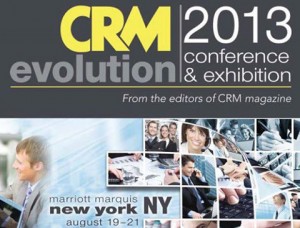I spent some at CRM Evolution 2013 last week doing something I really enjoy – getting out and talking to people. If you want to find out what’s going, you have to talk to people who are living it. This was a solid show, with SpeechTEK, CRM Evolution, and Customer Service Experience all sharing the same venue (attracting a rich base of attendees and providing a rich perspective on the Customer Experience – #CX – market). Here are some quick take-aways from my conversations with vendors, users, investors and even the occasional analyst at the event.
 1) LinkedIn is a large elephant with an image problem.
1) LinkedIn is a large elephant with an image problem.
LinkedIn, the mega-firm, was on display in the smallest, most unassuming booth possible. They were pitching a few partner relationships and promoting their premium services for “identifying personal sales opportunities”. Unspoken was the fact they have the rolodex and the horsepower to step into CRM (or any adjacent sales/lead sector) with near instant dominance. But they have a problem: user perception. Users (especially in the US) view LinkedIn as the trusted, refined social network – the one where their information is safe, and shared only among fellow business execs looking for personal connections. To move into the CRM or sales/lead market would require them to expose their members to the hard-core pitch, something that they can’t easily do without alienating their base (not a problem in Europe where it appears many LinkedIn users don’t have the same problem with being pitched to on LinkedIn).
What’s next: LinkedIn will solve this problem and implement something [in the CRM market] as soon as they are confident they do not need partnerships (or can be better served by acquisition).
2) The future of customer support is predictive and leverages AI.
We are on the cusp of CRM tools anticipating and proactively addressing customer needs (through narrow AI rule sets). This is a good thing, but I’m less than confident most vendors understand the trust, branding and Customer Experience issues they must address to make this feature work.
What’s next: the major vendors will watch and learn in this space, then run over the smaller players with their own solutions. Predictive is a feature, not a product.
3) Features are hot, products are not.
Features dominated the pitches of most vendors at the event. Feature advancement is a good thing, and indicative of a wave of rapid tech/service evolution. But while new features are great, and collectively can make a great product, they aren’t themselves enough to sustain a businesses. larger product and platform vendors will roll out their own set of features that make feature-only vendors obsolete.
What’s next: Smart “feature” vendors will either roll-up as many features as possible to create a mass and “app” advantage (good) or find a good partner to buy them out before their features become mere commodities (better).
4) CRM and CS both start with C. That’s about all they have in common.
I heard plenty of pitches that focused on the need for strong CRM and Customer Support (CS) components in an overall platform. I also heard plenty of approaches and plans to implement CRM and CS side by side with the ability to import/export information. But when it came to serious integration (CRM and CS as integrated features within a platform), I left a bit disappointed.
What’s next: Expect more partnerships and acquisitions as integrated CRM/CS becomes a key element of Customer Experience.
5) The future of artificial human support is human, for now.
SpeechTEK was collocated with #crme13 this year, offering a great opportunity to delve into the world of IVR (interactive voice response), something that partners well with my activities in the narrow, or applied, Artificial Intelligence arena (rule-base AI will quickly be at the heart of all-things-tech). Every now and then I run across something new. In this case it was humans mimicking computers.
As newer IVR systems become more “natural” in their interaction with people, there are still instances where the computer isn’t quite sure how to interpret a piece of information, or ask the right question of a user. It’s more than just dealing with thick accents, it drives to the different ways that people interact with each other culturally.
IVR systems have come a long way in their ability to process speech and ask the right questions. But what do you do when the IVR system just can’t get to the next step? You could kick the user out to a real person, but that might be viewed as a flaw in the system and drive the user to always push for a live person first. The alternative? Kick the user to a real person who impersonates the machine-base IVR. The customer is satisfied, believes the system works and nobody is the wiser. It makes sense, and is something I hadn’t really thought about going into the event.
What’s next: Expect more hybrid silicon/human systems – they are the (foreseeable) future of IVR and a solid Customer Experience.
If you were at any of the three events, and have a perspective to share, drop me a line – it’d be great to compare notes.
